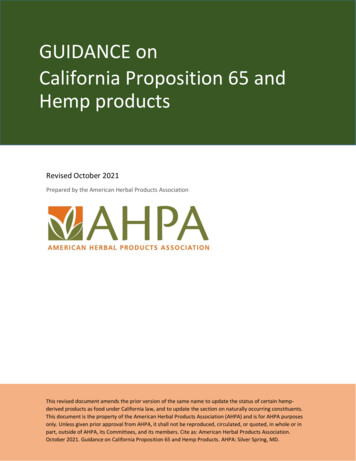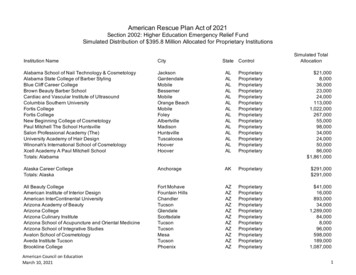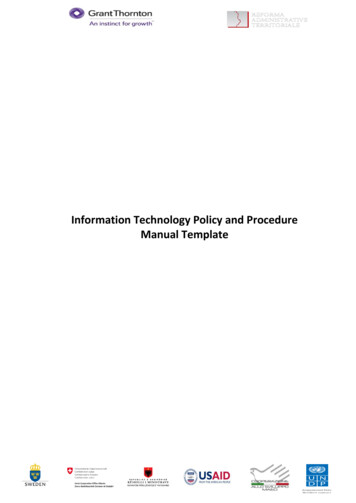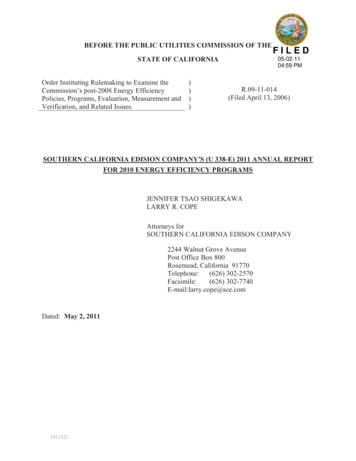
Transcription
GUIDANCE onCalifornia Proposition 65 andHemp productsRevised October 2021Prepared by the American Herbal Products AssociationThis revised document amends the prior version of the same name to update the status of certain hempderived products as food under California law, and to update the section on naturally occurring constituents.This document is the property of the American Herbal Products Association (AHPA) and is for AHPA purposesonly. Unless given prior approval from AHPA, it shall not be reproduced, circulated, or quoted, in whole or inpart, outside of AHPA, its Committees, and its members. Cite as: American Herbal Products Association.October 2021. Guidance on California Proposition 65 and Hemp Products. AHPA: Silver Spring, MD.
Guidance on California Proposition 65 and Hemp ProductsDISCLAIMERThe information contained herein is not and should not be considered to be legal advice. Thispublication is not a substitute for the California Proposition 65 laws and regulations that apply tobusinesses in the State of California. Instead, it should be viewed as a supplementary guide to theselaws and regulations. Information contained herein is not intended to replace or supersedeinstructions, guidelines or regulations issued by the State of California. In addition, no other issuesrelated to the manufacture, marketing, or sale of products entering commerce in California areaddressed herein.While AHPA believes that all of the information contained here is accurate, any company that usesthis information does so as its own choice; is wholly responsible for any policies establishedtherefrom; and is advised to discuss all aspects related to compliance with Proposition 65 with aqualified attorney or consultant. AHPA October 20211
Guidance on California Proposition 65 and Hemp ProductsTable of ContentsIntroduction and Background . 1General requirements . 3What warnings are required by Proposition 65? . 3Warnings provided by the product manufacturer . 3Warnings provided by the product retailer . 5Which chemicals require warnings under Proposition 65? . 6How much exposure to a chemical triggers a warning? . 6Who is responsible for all of this? Who is liable? . 7How is Proposition 65 enforced? . 7What should a company do if it gets a 60-day notice?. 8How can a company doing business in California best deal with Proposition 65? . 8Chemical testing under Proposition 65. 9Are specific levels established for these chemicals? . 9Heavy metals . 9Pesticides . 10β-Myrcene . 10How should heavy metals be tested in hemp and hemp-derived products? . 11Solid product forms. 12Liquid product forms. 13Where do heavy metals that are found in plant-based products come from? . 16What about “naturally occurring” chemicals? . 17β-Myrcene and Δ9-THC . 18Heavy metals . 19What is the relevance of settlements that have established “naturally occurring” levels for lead? . 19Averaging of exposures . 20 AHPA October 20212
Guidance on California Proposition 65 and Hemp ProductsIntroduction and BackgroundConsumer goods sold in the State of California are, with certain exceptions, subject to that State’sProposition 65, the Safe Drinking Water and Toxic Enforcement Act of 1986. The regulations that havebeen implemented in the years since the Proposition was passed place specific warning requirements onmarketers of products sold in the State of California if the product contains chemicals listed by the Stateas carcinogens or reproductive toxicants. Failure to provide such warnings can result in action by theCalifornia Attorney General or by “any person in the public interest.”Proposition 65 requires persons doing business to provide “clear and reasonable” warnings prior toexposing individuals to chemicals known to the State to cause cancer and/or reproductive toxicity. TheState is required to publish a list of the chemicals it considers to cause cancer and/or reproductivetoxicity.In the past decades numerous companies that sell or manufacture herbal products, including brandmarketers, contract manufacturers, and retailers, have been the subject of complaints filed orthreatened by several organizations and individuals and local district attorneys and the state attorneygeneral. These lawsuits have alleged that the products sold by these companies contain amounts ofheavy metals (primarily lead, and in some cases arsenic, cadmium and mercury) and other listedchemicals that require a warning. Companies that had not provided a warning prior to receipt ofcomplaints have reached settlements that have resulted in payments of up to 682,000 per company,with average settlements in the range of 85,000 to 100,000 per company.Also of concern are other chemicals on the Proposition 65 list that may be used in the cultivation andprocessing of hemp and marijuana, such as the pesticides myclobutanil and carbaryl, for which somecannabis businesses have received Proposition 65 notices.In January 2020, Δ9-tetrahydrocannabinol (Δ9 THC) was added to the Proposition 65 list as a chemicalknown to cause reproductive toxicity. The scientific basis for this classification is available from OEHHA.1While Δ9 THC is present at only trace levels in hemp products, companies marketing hemp products inCalifornia should evaluate whether a warning is needed for these products.This document was prepared with a narrow focus; it is concerned only with the regulatory and liabilityimplications of Proposition 65 for hemp and hemp-derived products, including cannabidiol (CBD), sold inthe State of California. This document does not address the implications of Proposition 65 for marijuanaproducts. It is not intended to address any other elements of Proposition 65 except as necessary for thepresent purpose, nor does it serve as a substitute for this law, its implementing regulations, or legalcounsel.AHPA has also produced the document Guidance on California Proposition 65 and Herbal Products,2which addresses the impact of this regulation to the broader herbal products industry and may also beof interest to the hemp industry. Another AHPA document, Guidance on California Proposition 65 andCannabis Products, addresses the specific impact of this law on the cannabis (non-hemp) products1This document is available at darthid100419.pdf.Accessed October 1, 2021.2This document is available through the AHPA website at px. AHPA October 20211
Guidance on California Proposition 65 and Hemp Productsindustry.3 AHPA produces periodic webinars on Proposition 65 to keep members of the regulatedindustry up to date on the latest developments from OEHHA regarding lead and other Proposition 65listed chemicals.For more information on this law see the website of the California Office of Environmental HealthHazard Assessment (OEHHA), which oversees Proposition 65 issues, at oehha.ca.gov/proposition-65.OEHHA also maintains a consumer-oriented Proposition 65 website at www.p65warnings.ca.gov.Additional helpful information is available at www.prop65news.com andwww.prop65clearinghouse.com.3This document is available through the AHPA website AHPA Prop65 Cannabis Guidance.pdf AHPA October 20212
Guidance on California Proposition 65 and Hemp ProductsGeneral requirementsWhat warnings are required by Proposition 65?Any company with ten or more employees that operates within the state or sells products in Californiamust provide a “clear and reasonable” warning before knowingly and intentionally exposing anyone to alisted chemical in an amount exceeding established standards (see “How much of a chemical?” below).The following sections provide examples of the general safe harbor warning language developed byOEHHA that can be used by marketers of hemp products. OEHHA is developing optional safe harborwarning language that can be used to provide a warning for specifically for Δ9 THC exposure. Thiswarning language will include tailored warnings for various routes of exposure Δ9 THC.Warnings provided by the product manufacturerProposition 65 warnings are typically provided by the manufacturer, producer, packager, importer,supplier, or distributor of a product in commerce in California, although any business in the chain ofdistribution may be sued if a plaintiff claims a required warning was not provided to exposed individualsin California.Food product warningsExamples of the Proposition 65 warnings as applicable to products that are derived from parts of thehemp plant that are “foods” (as discussed in the section “What about naturally occurring chemicals?”)are as follows: For any chemical listed as a carcinogen:WARNING: Consuming this product can expose you to chemicals including [name of one or morechemicals], which is [are] known to the State of California to cause cancer. For more information goto www.P65Warnings.ca.gov/food. For any chemical listed as a reproductive toxicant:WARNING: Consuming this product can expose you to chemicals including [name of one or morechemicals], which is [are] known to the State of California to cause birth defects or otherreproductive harm. For more information go to www.P65Warnings.ca.gov/food. For a chemical listed as a carcinogen and a different chemical listed as a reproductive toxicant:WARNING: Consuming this product can expose you to chemicals including [name of one or morechemicals], which is [are] known to the State of California to cause cancer, and [name of one ormore chemicals], which is [are] known to the State of California to cause birth defects or otherreproductive harm. For more information go to www.P65Warnings.ca.gov/food. For any chemical listed as both a carcinogen and as a reproductive toxicant: AHPA October 20213
Guidance on California Proposition 65 and Hemp ProductsWARNING: Consuming this product can expose you to chemicals including [name of one or morechemicals], which is [are] known to the State of California to cause cancer and birth defects or otherreproductive harm. For more information go to www.P65Warnings.ca.gov/food.Where any of the warnings above is being provided for an exposure to a single chemical, the words“chemicals including” may be deleted from the warning above, but in that circumstance the warning willonly cover the identified chemical.Where the warnings above are provided on a food or dietary supplement product label, the warningmust be set off from other surrounding information and enclosed in a box.Consumer product warningsFor hemp products that are not consumed, such as personal care products, the general consumerproduct safe harbor warning language may be used: For any chemical listed as a carcinogen:WARNING: This product can expose you to chemicals including [name of one or morechemicals], which is [are] known to the State of California to cause cancer. For more information goto www.P65Warnings.ca.gov. For any chemical listed as a reproductive toxicant:WARNING: This product can expose you to chemicals including [name of one or morechemicals], which is [are] known to the State of California to cause birth defects or otherreproductive harm. For more information go to www.P65Warnings.ca.gov. For a chemical listed as a carcinogen and a different chemical listed as a reproductive toxicant:WARNING: This product can expose you to chemicals including [name of one or morechemicals], which is [are] known to the State of California to cause cancer, and [name of one ormore chemicals], which is [are] known to the State of California to cause birth defects or otherreproductive harm. For more information go to www.P65Warnings.ca.gov. For any chemical listed as both a carcinogen and as a reproductive toxicant:WARNING: This product can expose you to chemicals including [name of one or morechemicals], which is [are] known to the State of California to cause cancer and birth defects or otherreproductive harm. For more information go to www.P65Warnings.ca.gov.Where any of the warnings above is being provided for an exposure to a single chemical, the words“chemicals including” may be deleted from the warning above, but in that circumstance the warning willonly cover the identified chemical. AHPA October 20214
Guidance on California Proposition 65 and Hemp ProductsCompanies can also comply with the warning regulation using the short-form warning option. Thiswarning option contains a symbol consisting of a black exclamation point in a yellow equilateral trianglewith a bold black outline4 placed to the left of the warning text, as well as the following: For consumer products that cause exposures to a listed carcinogen:WARNING: Cancer - www.P65Warnings.ca.gov.For consumer products that cause exposures to a listed reproductive toxicant:WARNING: Reproductive Harm - www.P65Warnings.ca.gov.For consumer products that cause exposures to both a listed carcinogen and a reproductivetoxicant:WARNING: Cancer and Reproductive Harm - www.P65Warnings.ca.gov.For short-form warnings, the warning language must be no smaller than the largest type size used forother consumer information5 on the product, and in no case shall the warning appear in a type sizesmaller than 6-point type. Short-form warnings are not required to include the name or names of alisted chemical within the text of the warning.Warnings provided by the product retailerThe manufacturer, producer, packager, importer, supplier, or distributor of a product may also complywith the Proposition 65 warning requirements by providing a written notice directly to the authorizedagent for every retail seller of the product in the State of California, which includes all of the following:1. States that the product may result in an exposure to one or more Proposition 65 listedchemicals;2. Includes the exact name or description of the product or specific identifying information for theproduct such as a Universal Product Code (UPC) or other identifying designation;3. Includes all necessary warning materials such as labels, labeling, shelf signs or tags, and warninglanguage for products sold on the Internet;4. Has been sent to the retail seller, and the manufacturer, producer, packager, importer, supplier,or distributor has obtained confirmation electronically or in writing of receipt of the notice.The product retailer is directly responsible for providing Proposition 65 warnings to consumers undercertain other circumstances, such as when the retailer knowingly introduces a listed chemical into theproduct, or when the retailer obscures a warning label that has already been affixed to the product.4If the sign, label, or shelf tag for the product is not printed using the color yellow, the symbol may be provided inblack and white. The warning symbol can be downloaded from the OEHHA website.5 “Consumer information” includes warnings, directions for use, ingredient lists, and nutritional information.“Consumer information” does not include the brand name, product name, company name, location ofmanufacture, or product advertising. AHPA October 20215
Guidance on California Proposition 65 and Hemp ProductsWhich chemicals require warnings under Proposition 65?Proposition 65 requires the State of California to publish and maintain a list of chemicals known to causecancer or reproductive toxicity. The list is updated periodically; the most recent list is accessible on theOEHHA website.6Chemicals can be added (or occasionally removed) from the list by various mechanisms, such as adeclaration by an authoritative body or by scientific testing.Of interest to any company that sells herbal products such as those derived from hemp, or anyconsumer product manufactured from plants for that matter, are certain heavy metals. Metals such asarsenic, cadmium, lead and mercury are found in soils all over the world, both in naturally occurringamounts and in some cases as a result of human activity over the centuries. Each of these metals is onthe current Proposition 65 list as reproductive toxins, i.e., as chemicals capable of causing birth defectsor other reproductive harm if consumed in sufficient quantity. In addition, arsenic and lead are listed ascarcinogens by oral ingestion and cadmium is listed as a carcinogen by inhalation.Of these four heavy metals, it is lead that requires the most attention for botanical ingredients such asthose derived from hemp. Lead is found almost everywhere in the environment, both as a result ofnatural processes and sometimes as a byproduct of the use of fossil fuels, lead-containing agriculturalchemicals, and leaded brass implements for harvesting, processing, or irrigating plants. As with otherheavy metals, lead is readily absorbed into the tissues of many plants. And the level of lead that requiresa warning (see below) is exceptionally low.With the addition of Δ9 THC to the Proposition 65 list on January 3, 2020, hemp companies have a oneyear compliance period until January 3, 2021 to implement Proposition 65 warnings, if required, for anyproducts marketed in California. Subsequent to this date, and in the absence of OEHHA setting aMaximum Daily Allowable Level (MADL) safe harbor value for Δ9 THC, it is possible that some marketersof hemp products containing detectable amounts of Δ9 THC may need to provide a compliantProposition 65 warning. The listing of Δ9 THC under Proposition 65 is not limited to specific routes ofexposure, so a warning for potential exposure to Δ9 THC may be needed for products that are consumedorally, topically, or that are inhaled.Other listed chemicals of interest to hemp companies include the terpene β-myrcene, which is aconstituent of hemp plants, and pesticides such as myclobutanil and carbaryl, for which some cannabisbusinesses have received Proposition 65 notices.How much exposure to a chemical triggers a warning?Proposition 65 mandated warnings are not required when a product presents exposure to listedchemicals below certain levels. For carcinogens, this level is one that “poses no significant risk assuminglifetime exposure at the level in question.” Said another way, and according to OEHHA:6OEHHA revises this document on a regular basis. Please see the following url for access to the mostrecent version - -list. AHPA October 20216
Guidance on California Proposition 65 and Hemp ProductsFor a chemical that is listed as a carcinogen, the “no significant risk” level is defined as the levelwhich is calculated to result in not more than one excess case of cancer in 100,000 individualsexposed over a 70-year lifetime. In other words, if you are exposed to the chemical in question atthis level every day for 70 years, theoretically it will increase your chances of getting cancer byno more than 1 case in 100,000 individuals so exposed.For reproductive toxicants the level below which a warning is not required is that which “will have noobservable effect assuming exposure at one thousand (1000) times the level in question.” According toOEHHA:For chemicals that are on the list as reproductive toxicants, the no significant risk level is definedas the level of exposure which, even if multiplied by 1,000, will not produce birth defects or otherreproductive harm. That is, the level of exposure is below the “no observable effect level (NOEL),”divided by 1,000. (The “no observable effect level” is the highest dose level which has not beenassociated with an observable reproductive harm in humans or test animals.)Who is responsible for all of this? Who is liable?The law states that “No person in the course of doing business shall knowingly and intentionally exposean individual to a chemical known to the state to cause cancer or reproductive toxicity without firstgiving clear and reasonable warning to such individual” -- unless a defense to the warning requirementapplies. This “person” can be any company in the stream of commerce, e.g., a manufacturer, distributoror retailer. Enforcement is most often against the manufacturer of a product, but there have been casesbrought against retailers.Companies with fewer than ten employees are exempt from the requirements to provide warningsunder Proposition 65. However, both the California Attorney General and private enforcers have takenthe position that Proposition 65 liability applies to any company with ten or more employees that is inthe stream of commerce for the product. In this view, a manufacturer with fewer than ten employeeswould not be liable under Proposition 65, but its distributors and retailers, assuming they each have atleast ten employees, could be liable. As a result of common indemnity practices and business customs,therefore, the small manufacturer may still be asked to take financial responsibility for compliance by ora lawsuit against the larger distributor or retailer.How is Proposition 65 enforced?This law is enforced by civil suits against companies that are alleged to be in violation of itsrequirements. The State Attorney General and local district and city attorneys have authority to takesuch actions, but, unlike most of the laws in the State of California, such a suit may also be brought by“any person in the public interest.” Almost all of the cases that have been brought against herbalproducts companies to date have, in fact, been the result of actions by private plaintiffs outside ofgovernment offices.An action against a company by a private plaintiff will be initiated by a “60-day Notice.” In this Noticethe company is informed that the plaintiff claims violations of Proposition 65 and intends to bringenforcement action against the company within 60 days unless the Attorney General has first begun toprosecute the company for the alleged violations. AHPA October 20217
Guidance on California Proposition 65 and Hemp ProductsThe violations described in the cases involving herbal companies have been based on allegations by theplaintiffs that, although the company’s products do not bear Proposition 65 warning labels, there areone or more listed chemicals in the company’s products at levels that in fact require warnings. In severalcases the Notices have attached an Appendix that lists the company’s entire product line.Proposition 65 generally places the burden of proof on the defendant. Once a company has received a60-day Notice, the company will be required to defend against the alleged violation. A company mayalso be called upon to prove that its customers actually use their products in the amounts specified onthe labels. Furthermore, although the law specifies that exposure be made “knowingly andintentionally,” these terms as they are usually understood typically have not proven to be a practicalimpediment to enforcers in the past.The law specifies that civil liability in a Proposition 65 action “shall not exceed 2,500 per day for eachviolation.” The Proposition 65 statute does not define what constitutes a “violation.” Plaintiffs typicallyargue that a violation occurs each time that each consumer consumes a daily serving of a product, suchthat a broadly sold product can be argued to represent a large number of violations each day. In the fewcases that have gone to trial where a court is determining the civil penalty, the courts generally haveviewed each violation as each unit sale to a consumer in California without a required warning duringthe relevant period. As stated at the outset, payments and attorney fees of up to 682,000 have beenlevied against some manufacturers of herbal dietary supplement products whose products were allegedto contain heavy metals in amounts that were in excess of the established “safe harbor” levels.What should a company do if it gets a 60-day notice?The defense of a lawsuit brought under California Proposition 65 is a complex process requiring specialexpertise. It is strongly advised that anyone in receipt of a 60-day Notice contact an attorney who isknowledgeable about this law. AHPA maintains communications with several legal firms who specializein environmental and consumer law and can sometimes provide an introduction.How can a company doing business in California bestdeal with Proposition 65?The best advice would appear to be simple: know your products. That said, companies should be awarethat any testing they perform may be discoverable by prosecutors and therefore used against them, solegal advice should be sought on these issues.Articles have been published in scientific journals that have recorded laboratory analyses of heavymetals in herbal products at levels that may require warnings under Proposition 65, depending onserving sizes, naturally occurring levels, and other factors. At this time there are also the existing casesand settlements that have occurred in the past several years. Any company selling herbal products suchas those derived from hemp should be prepared to answer any charges that are brought against them inthis matter promptly, as the burden of proof is on the company. AHPA October 20218
Guidance on California Proposition 65 and Hemp ProductsChemical testing under Proposition 65Are specific levels established for these chemicals?The burden of showing that an exposure is below the threshold levels is on the company that “exposes”the consumer to a product. OEHHA has, however, established “safe harbors” for many chemicals on theState’s lists, including most of the heavy metals that may be of interest to marketers of hemp-derivedproducts. These levels are stated as “no significant risk levels” (NSRL) for chemicals listed as carcinogensand as “maximum allowable daily levels” (MADL) for chemicals listed as reproductive toxins. OEHHA hasadopted “safe harbor” NSRLs and MADLs for about half of the over 900 chemicals listed underProposition 65. If OEHHA has not published a safe harbor NSRL or MADL for a chemical, the burden fallsto a defendant in litigation to prove the right NSRL or MADL for the chemical.Heavy metalsNSRL and MADL levels for arsenic, cadmium, lead and mercury are given in Table 1. All quantities arethose that are given in OEHHA’s publication of March 2019, Proposition 65 No Significant Risk Levels(NSRLs) for Carcinogens and Maximum Allowable Dose Levels (MADLs) for Chemicals CausingReproductive Toxicity7 unless otherwise stated.Table 1 – Current “safe harbor” levels of relevant heavy metalsCarcinogenReproductive toxicantNSRL ( g/day)MADL ( g/day)arsenic a10 bnone established ccadmium0.05 (inh) d4.1150.5none established fnone established gleadmercury eabcThe specific listed carcinogenic chemical is “arsenic (inorganic arsenic compounds);” that listed as adevelopmental toxin is “arsenic (inorganic oxides).”Limit for inhaled arsenic is 0.06 g/day; the level given here is the limit for exposure by other routes,e.g., ingestion, and is given for the specific listed chemical “arsenic (inorganic arsenic compounds)”.“Arsenic (inorganic oxides)” is listed in the September 2012 publication8 as a “second priority” forestablishment of a MADL. In October 2007 this chemical was listed as a “first priority,” and a “draft oralMADL” of 0.1 g/day was published by OEHHA in 2003. At least one settlement from July 2008establishes a limit of 10 µg/day as total arsenic.97See the following link for the latest list of safe harbor levels: rls-maximum. Accessed on April 24, 2019.8 Priority List for the Development of Proposition 65 Safe Harbor Levels. OEHHA, September 2012 Update.9 One such example settlement is found in Steven D. Gillett v. Madison One Acme Inc., a Company doing business a
this information does so as its own choice; is wholly responsible for any policies established . Proposition 65 warnings are typically provided by the manufacturer, producer, packager, importer, . such as










